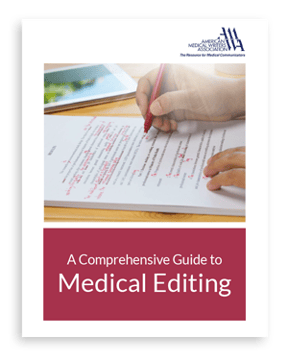
There are many different paths to becoming a medical editor. Some editors work as freelance contractors, while others are hired by organizations.
Medical editors need to have a deep passion for science and writing. They also must understand medical concepts and be able to interpret and explain the meaning of data to various audiences.
An advanced degree is not required to become a medical editor, but some have earned medical or science degrees. Others have experience in academic settings or as bench scientists, pharmacists, physicians, or other health care professionals. Sometimes an editor will have a master’s or doctorate in communications or English.
There are also several certificates and certifications, including the AMWA Certificate in Medical Editing, that are useful in demonstrating knowledge and proficiency.
Assess Skills and Abilities
Medical editors arrive in the field from various disciplines and backgrounds. People with medical or science backgrounds commonly benefit from refreshers in writing and editing mechanics, whereas people with editorial experience may need to focus on medical terminology and statistics.
Before applying for a program or position, aspiring medical editors should take an inventory of their skills, both quantitatively and qualitatively.
The following are some areas that all medical communicators, writers and editors alike, need to master:
-
Grammar and usage
-
Medical terminology
-
Professional ethics
-
Punctuation
-
Sentence and paragraph structure
-
Statistics
-
Tables, graphs, visual abstracts, and other illustrative materials
The AMWA Essential Skills Certificate Program addresses all of these topics.
An Essential Skills certificate will help determine whether you have the skills to become a good scientific/medical editor. It’s important to be realistic about your skill level, including how well you can create clarity in a document.
Gain Experience in Editorial and/or Scientific Settings
Most medical editors have experience in editorial settings, scientific positions, or both. In these professional settings, they learn the ins and outs of the editorial process, the flow of documents and information, and the organizational culture that is key to working successfully.
The experience required varies depending on the hiring organization and the job responsibilities. Some people gain experience by volunteering to edit grants, publications, or other documents for a nonprofit organization. Some get a foot in the door by volunteering to edit a paper for an organization with a job opening in order to demonstrate their skills. Some employers may make exceptions for candidates with limited formal experience when they prove they can do the job.
No matter what your entry point is, it is important to choose a focus.
Choose a Focus
A wide range of companies and organizations employ medical editors, and the field is generally divided into different specialties, each requiring specific editing skills or knowledge of medical terminology and practices.
-
Continuing education for health care professionals
-
Grant proposals
-
Health communication
-
Marketing/Advertising/Public relations
-
Medical journalism
-
Non–peer-reviewed publications for professional audiences
-
Patient education
-
Peer-reviewed journals
-
Regulatory writing
-
Sales training (biotech or pharmaceutical industry)
-
Scientific publications
Get Appropriate Training and/or Certification
Different organizations require editors with different skills. Most academic institutions require highly skilled substantive editors with analytical skills for work in scientific publications. Scientific/medical journals and publishing companies may hire editors with fundamental or copyediting skills or editors with experience in journal or book management. Pharmaceutical companies, device manufacturers, and medical communication agencies may hire editors with various skill levels, depending on the specific job responsibilities.
Several resources are available for assessing and acquiring the skills needed to become a medical editor.
AMWA has several such resources, including the Essential Skills modules that cover the basics of medical communication. These types of training opportunities can help sharpen writing and editing skills, enhance knowledge of medical terminology and statistics, and reinforce an understanding of medical ethics and practices.
In this day and age, training options abound. Aspiring medical editors and those already working in the field can explore online or in-person courses, check out self-paced virtual options, or attend conferences and events that offer educational opportunities.
Certification for Medical Editors
Many of the skills needed to succeed as a medical editor overlap with those of medical writers. The following are a few examples of applicable programs:










